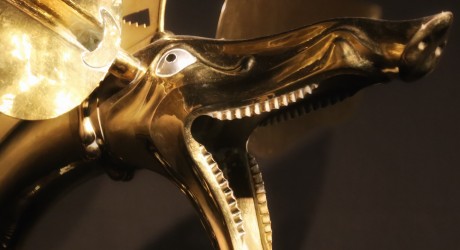RESEARCHERS from a pan-European music project have uncovered the ancient musical history behind the pop, rock and dance scenes we are accustomed to enjoying today, involving vulture bones, sea-shells and boar-headed brass horns, traced back to early humans and their Neanderthal predecessors.
From the Cave to the Rave is a musical journey from the sounds of pre-history through to the musical traditions that still survive today. Using reconstructions of ancient musical instruments, artists from across Europe will bring the music of our ancestors to life in the first concert of its kind to be held in the UK.
If you haven’t heard the roar of a Celtic Carnyx, the enchantment of a Greek Kithara or the melodic sounds of the Roman Tibia, then now is your chance at the world premiere of From the Cave to the Rave on Saturday April 9, 7.30pm at the Royal Conservatoire of Scotland.
From the Cave to the Rave, produced under the artistic direction of Emiliano Li Castro and hosted by the Royal Conservatoire of Scotland, is a key output of the European Music Archaeology project (EMAP) of which the Royal Conservatoire of Scotland is a co-organiser, along with nine other European partners in Austria, England, Italy, Sweden, Spain, Cyprus and Germany.
“This concert is one of a kind. The musicians will take the audience on a special journey through our common past, dating back many thousands of years, it’ll be time travel through music,” explained director, Emiliano Li Castro
“Exact reproductions of ancient musical instruments and sound tools, from European prehistory until the dawn of Western Music, will be gathered together here in Glasgow for the very first time, and played by a large ensemble of musicians.
“Each instrument has been carefully crafted after original archaeological finds, dating from Upper Palaeolithic to the end of the Viking Age allowing the audience to travel in time, on the waves of the sounds of our ancestors.”
Long before the Old Continent became known as Europe and before the presumed ‘history of music’ began, musical instruments played a key role in creating a network of interconnections, cross-references and shared features among the various European cultures.
EMAP travels in time from the Upper Paleolithic period (ca 40,000 B.C.), the era some ancient findings date back to, through the great classical civilizations, down to the present day. Since the 1970’s, a small but growing number of music archaeologists including Nordic pioneer Cajsa S. Lund, have examined the survival and resilience of ancient music making, as witnessed in the traditional music that is still alive in Europe.
The main attractions of the project are some of the most fascinating musical devices ever created by man during different historical periods and the many interconnections they produced. From the Cave to the Rave is an opportunity for the audience to get acquainted with bone flutes, double and triple pipes, carnyxes kitharas and other musical traces scattered all over Europe by homo sapiens, and perhaps even by their Neanderthal predecessor.
EMAP is the first organic journey from the sounds of Prehistory through to traditions which still survive today, taking us from very early music to the present day composer and blending archaeology and art, science and creativity.
The multi-faceted project travels back into the interconnected musical past of Europe, increasing awareness of our common heritage and bringing the profile of music archaeology to the general public.
This is achieved through Archaeomusika, a travelling multimedia exhibition focused on ancient European musical instruments and music, highlighting reproductions of archaeological finds, and an accompanying event programme, including music performances in which the ancient world of sound is brought back to life as well as international conferences, lectures, workshops, and school programmes.
Archaeomusika and the accompanying event programme will open in Ytsad (Sweden) on the 6th June 2016 and initially tour in Valladolid (Spain), Ljubljana (Slovenia), Rome (Italy) and Paphos (Cyprus) with more European venues to follow.
Further output includes a series of CDs featuring reconstructions of ancient music, a film documentary produced by Royal Conservatoire of Scotland staff and students and publications such as an exhibition catalogue, conference proceedings and a children’s book.
More information about the project and partners can be found here:
Media contact: Press Office, RCS, 0141 270 8387 communications@rcs.ac.uk
Press tickets available.
ENDS
MEDIA RELEASE issued by RCS. You too can post media releases (aka press releases) on allmediascotland.com. Email here for more information.
Check out twitter.com/newsdipper for your very own media releases feed…
Check out too twitter.com/allMusicPR, twitter.com/allTheatrePR and twitter.com/allEducationPR.
To catch up on all the media releases recently posted on to allmediascotland.com, you need only click the link icon that you see towards the bottom right of our two media release ‘gateway boxes’.
Contact: Katie Bell
Phone: 01412708387
Email: k.bell@rcs.ac.uk
Website: http://www.rcs.ac.uk







